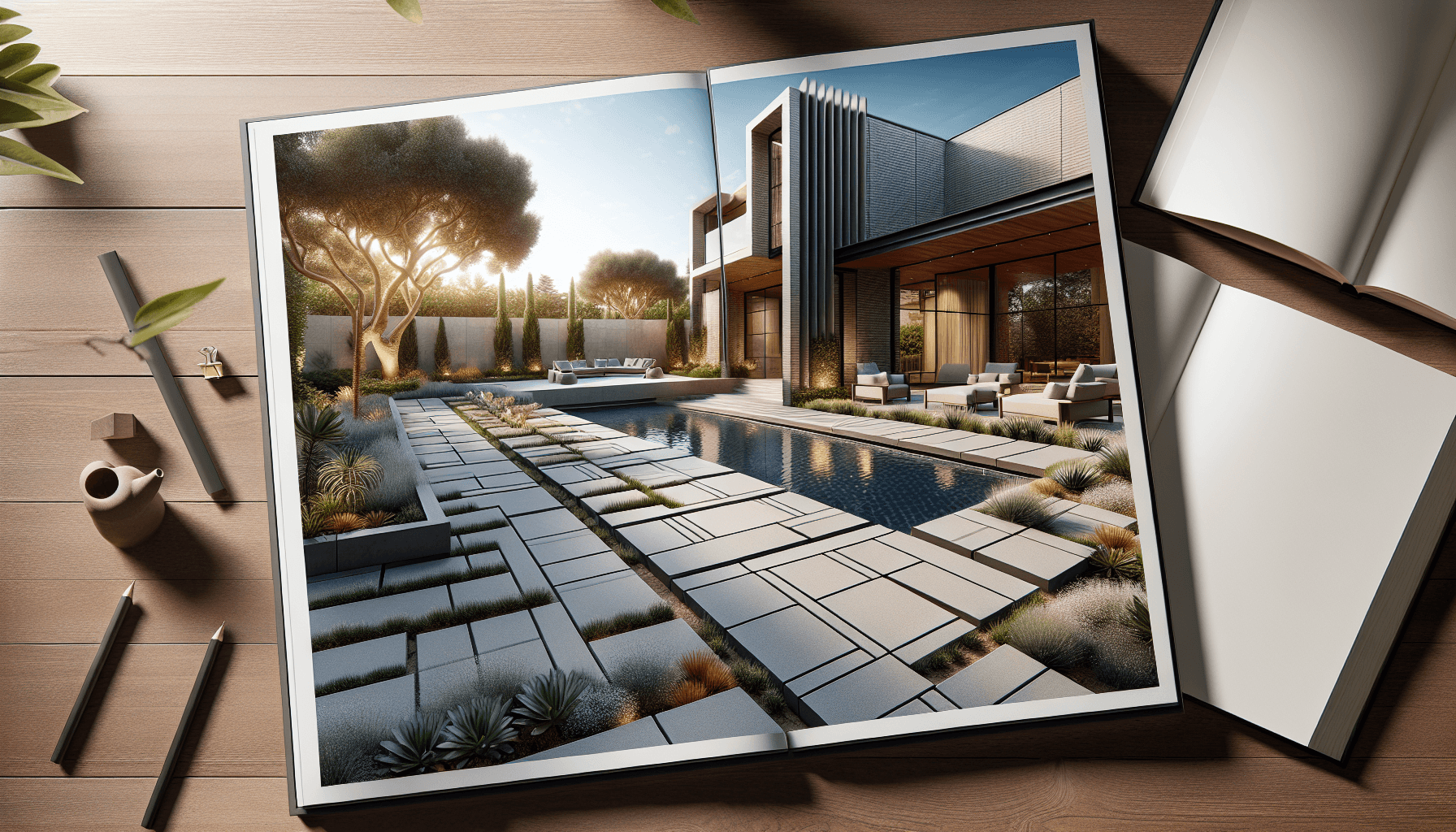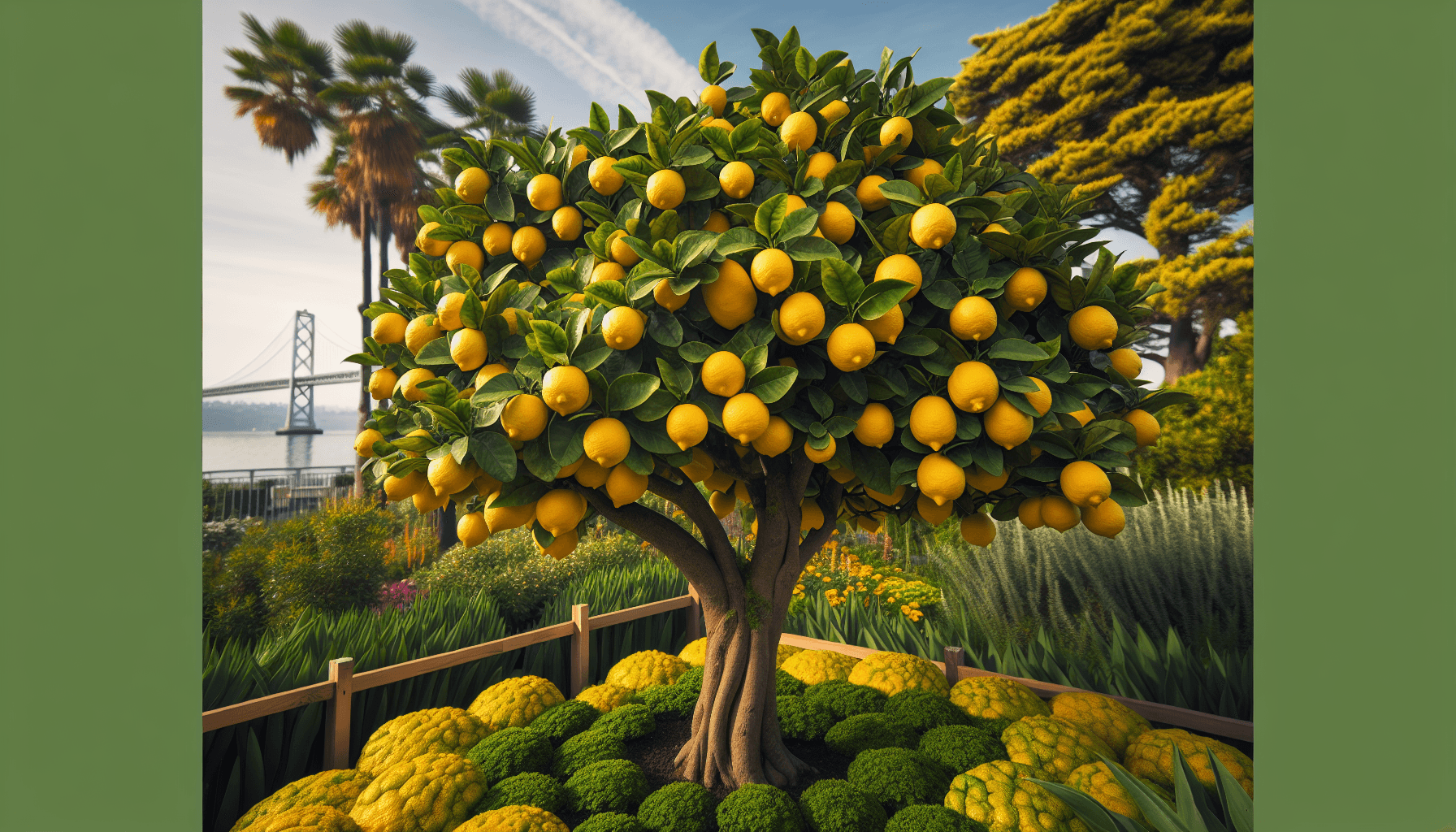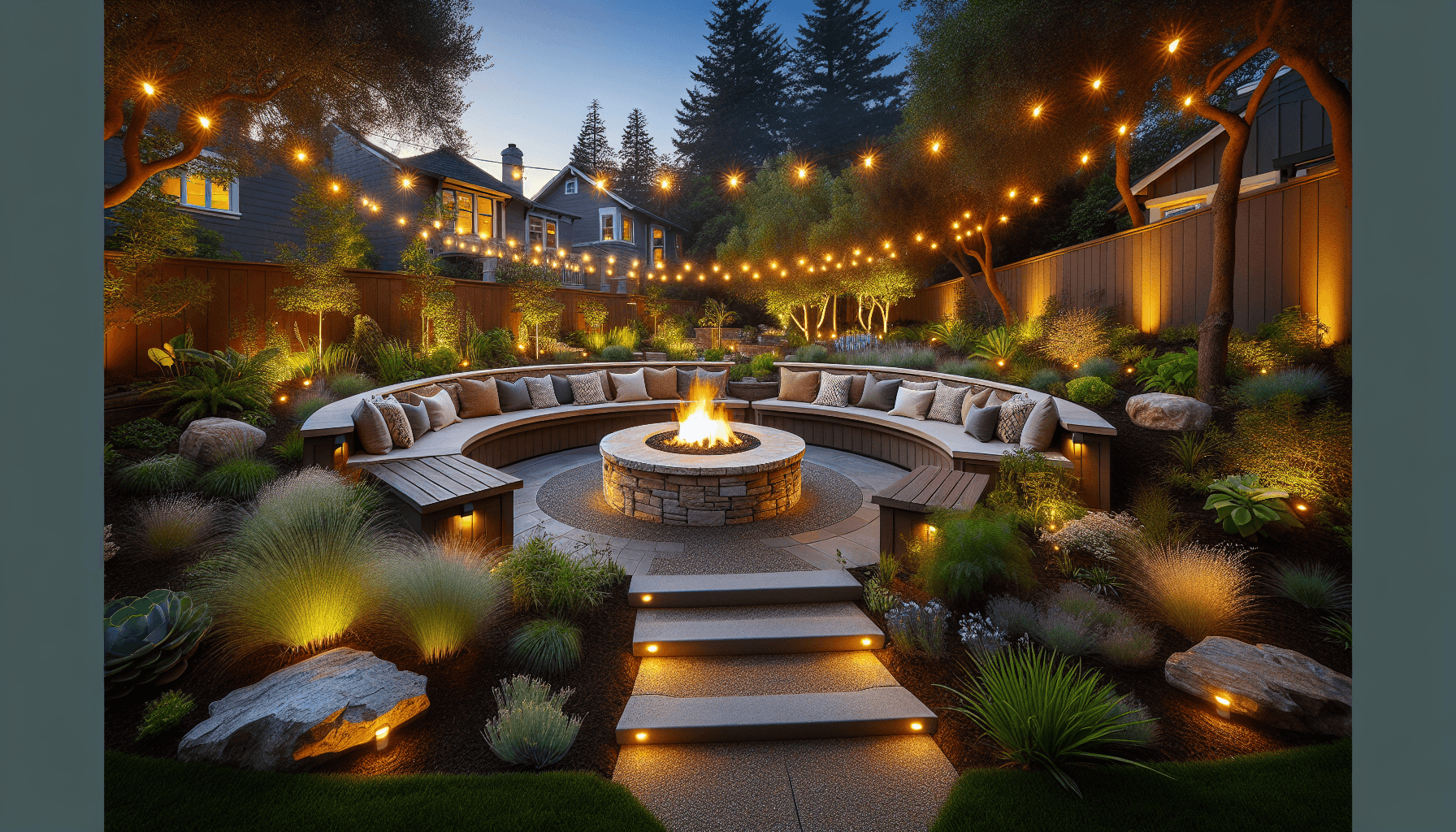I'll never forget the Patels' driveway disaster in Cupertino. When I first visited their property, I found them staring glumly at a year-old stamped concrete driveway that had developed a crack you could fit your finger into. "The contractor said this would look like pavers for half the price," Mr. Patel explained, frustration evident in his voice. "Now we've got a crack running straight through our 'brick' pattern, and three different concrete repair specialists told us there's no way to fix it invisibly." That crack—a reminder that material selection determines decades of performance—cost them not just money but the peace of mind that comes with knowing you've built something right.
As a landscape designer serving Bay Area communities for over fifteen years, I've guided hundreds of clients through hardscaping material decisions. The right choice transforms properties—creating outdoor living spaces that enhance daily life while requiring minimal maintenance. The wrong choice? It haunts homeowners for decades, demanding constant upkeep, repairs, and eventual replacement. Today's hardscaping market offers unprecedented options, from time-tested concrete pavers to cutting-edge porcelain systems, each with distinct performance characteristics that matter tremendously in our unique Bay Area climate.
Why Hardscaping Material Selection Defines Your Landscape Design
Working as a landscape designer in Palo Alto, Los Altos, and surrounding communities, I approach hardscaping material selection as one of the most critical decisions in any landscape design project. Unlike softscape elements that can be adjusted or replaced relatively easily, hardscaping represents permanent infrastructure that will serve your property for 30-50 years or more.
The materials you choose for driveways, patios, walkways, and pool decks don't just affect initial construction budgets—they determine maintenance requirements, repair possibilities, aesthetic longevity, and ultimately whether your outdoor spaces enhance or diminish property value. I've watched clients make decisions based solely on upfront savings only to face thousands in maintenance costs within a few years. Conversely, I've seen strategic material investments deliver maintenance-free performance for decades.
Bay Area Climate Advantages for Hardscaping
Mild Winters Extend Material Lifespan
Our temperate climate lacks the freeze-thaw cycles that destroy hardscaping in harsher regions. Materials that might last 20-25 years in the Northeast easily achieve 40-50 year lifespans here. This climatic advantage makes the Bay Area ideal for hardscaping investments.
Year-Round Outdoor Living Justifies Quality
Unlike regions where outdoor spaces sit unused for months, Bay Area residents enjoy patios, decks, and outdoor kitchens nearly year-round. This extended use justifies investing in premium materials that deliver superior performance and aesthetics.
Clay Soils Demand Flexible Systems
Many Bay Area properties feature expansive clay soils that shift with moisture changes. Interlocking paver systems accommodate this movement without cracking, while rigid poured concrete often fails within years.
Concrete Pavers: The Hardscaping Workhorse
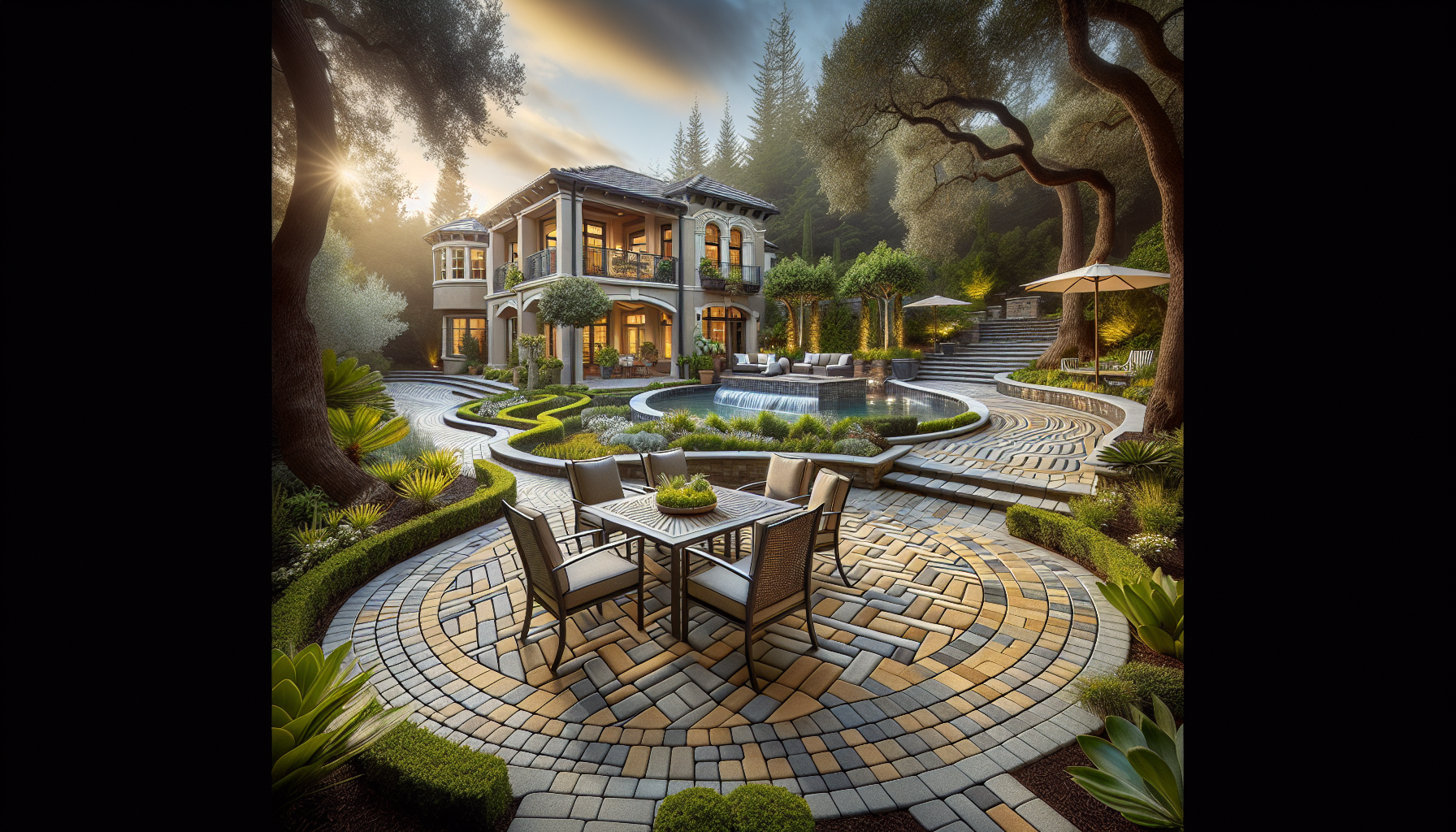
Belgard concrete pavers create clean, contemporary lines perfect for modern Bay Area architecture
Concrete pavers dominate Bay Area hardscaping installations for excellent reasons. When I specify Belgard products for projects—and I do regularly—it's because modern concrete pavers deliver exceptional engineering performance that justifies their market position. These aren't your grandfather's plain gray pavers. Today's premium concrete paver systems rival natural stone aesthetically while exceeding it functionally.
Technical Performance That Matters
Quality concrete pavers achieve 8,000 PSI compressive strength—approximately three times stronger than poured concrete and forty times stronger than required for fire truck loading. This isn't marketing hyperbole; it's ASTM C936/C936M compliance that determines whether materials meet commercial specifications.
The load-bearing capacity exceeds AASHTO H-20/HS-20 specifications, meaning properly installed concrete pavers withstand highway loading requirements. In Bay Area's clay soils prone to expansion and contraction, the interlocking design distributes stress across multiple units while sand-filled joints accommodate thermal expansion and ground movement without cracking. This flexibility explains why well-specified paver driveways outlast poured concrete alternatives.
Water absorption averages 5%, with freeze-thaw resistance far exceeding what our mild climate demands. This excess durability translates to extended lifespan—where materials facing harsh northeastern winters might last 20-25 years, they easily achieve 40-50 years in our temperate conditions.
Belgard Catalina Grana: Contemporary Minimalism
For landscape design projects requiring clean, contemporary aesthetics, Belgard's Catalina Grana exemplifies modern concrete paver engineering. This smooth, linear system features crisp lines that satisfy both ADA compliance requirements and architect specifications for minimalist designs.
The three-piece modular system includes 6"x12", 9"x12", and 12"x12" pavers at 2-3/8" thickness (60mm), with each pallet covering 120 square feet. Available colors span from Aspen and Bella to Riviera, Toscana, and Victorian, providing versatility for both contemporary and transitional Bay Area architectural styles.
The smooth surface proves particularly valuable for wheelchair accessibility and high-traffic commercial courtyards. For driveway applications, I specify only the 60mm thickness to ensure appropriate load-bearing capacity. This attention to specification details separates professional landscape design from amateur installations.
Belgard Dimensions: Premium Performance and Flexibility

Dimensions line offers unprecedented pattern flexibility with premium fade resistance
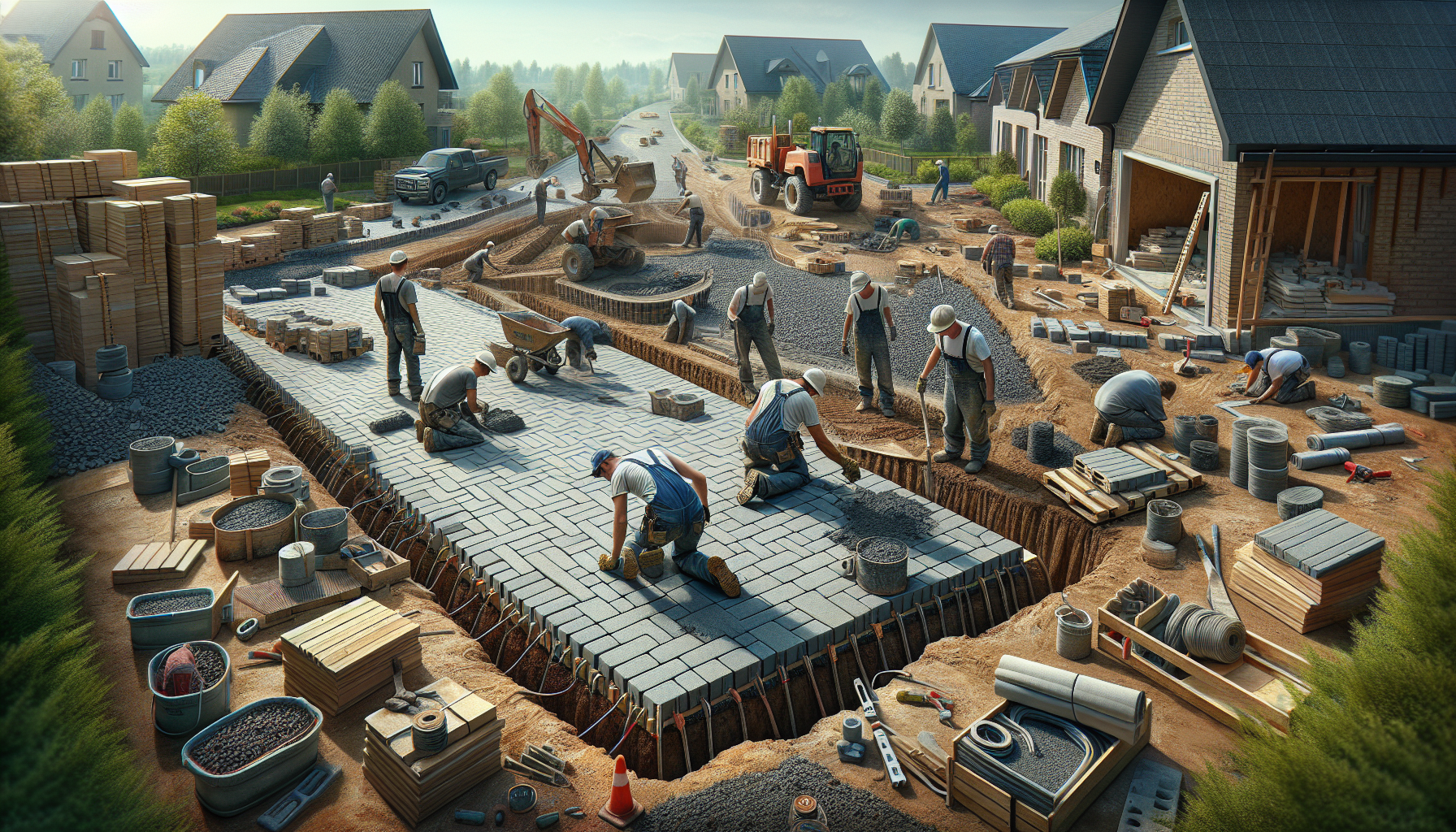
Professional installation ensures pattern precision and long-term performance
The Dimensions line represents Belgard's premium concrete paver collection, and I specify it when projects demand superior fade resistance and design flexibility. What justifies the premium? DURAFUSION technology fuses a top layer of rich pigments with core color, delivering exceptional longevity compared to standard integral coloring methods.
More critically for professional specifications, Dimensions offers three distinct size categories that can be mixed for unprecedented pattern flexibility. Dimensions 6 (with 3"x6", 6"x6", and 6"x9" sizes) stands as the only Dimensions configuration rated for driveway and vehicular applications. Dimensions 12 and 18 provide larger format options (up to 27"x18") that create contemporary linear aesthetics while maximizing installation efficiency through reduced cuts and joints.
Color selection reveals Belgard's understanding of current Bay Area design preferences. Scandina Gray and Shaded Gray dominate contemporary installations, while Fossil Beige and Linen Beige provide warm neutrals for traditional aesthetics. Premium colors like Cheswick, Cliffside, and Potomac incorporate both DURAFUSION and COLORTECH core coloring for maximum depth and longevity. The micro-chamfer detail (3mm width) minimizes vibration and enhances wheelchair comfort while creating subtle shadow lines that emphasize clean geometry.
Holland Stone and Cambridge Cobble: Versatile Classics
For landscape designers seeking maximum versatility, Holland Stone remains indispensable. This classic 4"x8"x2-3/8" rectangular paver delivers exceptional strength through maximum interlock while its simple shape facilitates borders, accents, and traditional patterns. The simplicity that makes Holland Stone economical also makes it endlessly adaptable—it pairs seamlessly with premium pavers like Dimensions for field-and-border designs, functions equally well in contemporary and traditional contexts, and proves straightforward enough for skilled DIY installations while meeting professional standards for commercial applications.
Cambridge Cobble occupies a different niche, offering architectural elegance through its pillow-top surface and gently rounded corners. The two-piece system (6"x6" and 6"x9") proves ideal for circular designs, curved walkways, and intricate patterns that would prove challenging with rectilinear pavers. Bay Area suppliers commonly stock Victorian and Toscana colors, recognizing these blends complement the region's Mediterranean-influenced architecture. The domed surface texture provides inherent slip resistance while the rounded profile creates organic, flowing designs particularly suited to garden pathways and pool deck surrounds.
Porcelain Pavers: The Premium Future of Hardscaping
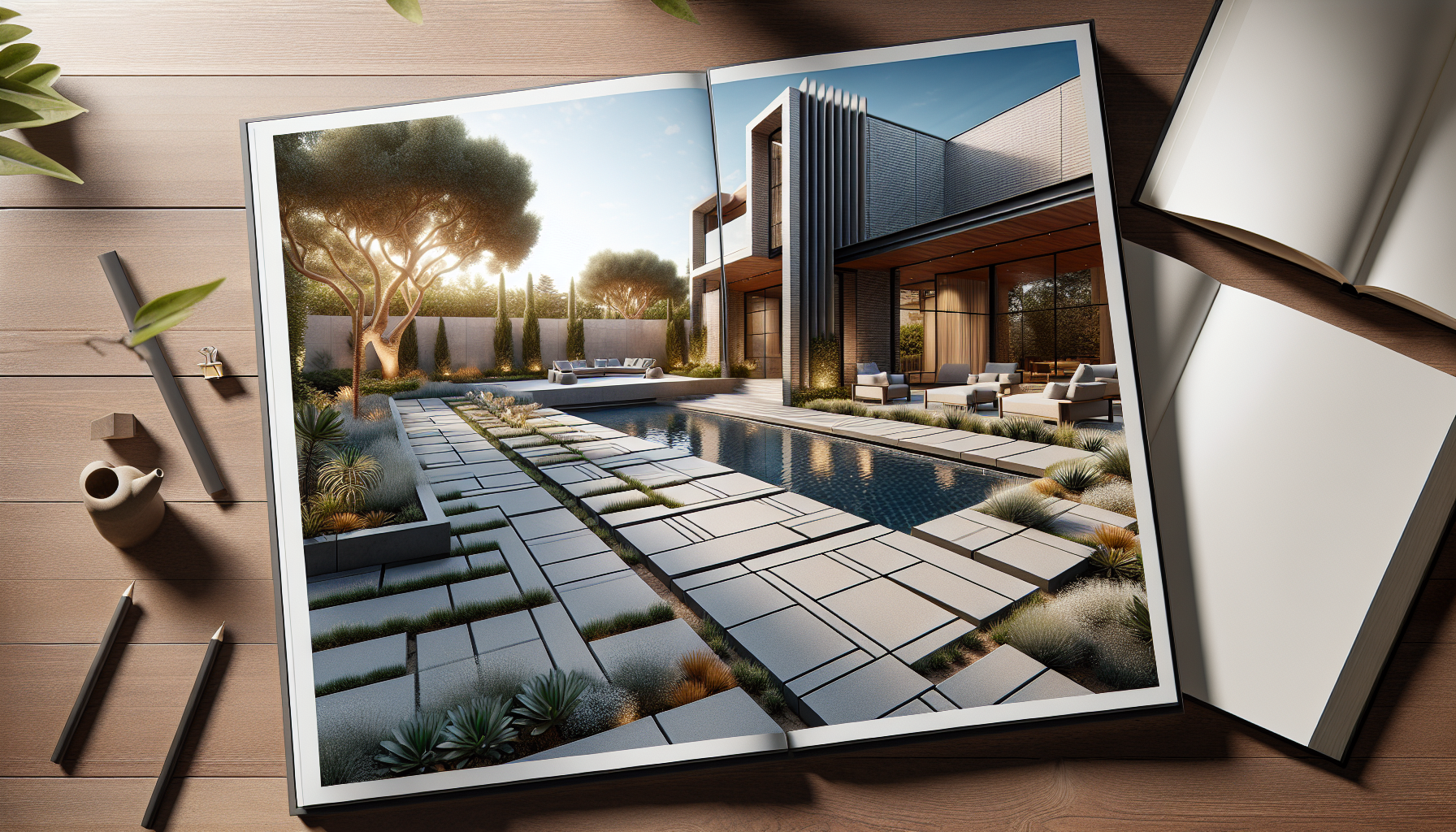
Porcelain pavers stay cool underfoot while delivering zero-maintenance performance for pool decks
Bay Area homeowners increasingly encounter porcelain pavers as I specify them for high-end projects where lifecycle value justifies premium upfront investment. These large-format ceramic pavers fired at 1,200-1,400°F represent a fundamentally different material category than concrete pavers, with performance characteristics that demand separate analysis.
MSI Arterra: Premium Performance Meets Bay Area Availability
MSI's Arterra porcelain pavers provide excellent Bay Area availability through multiple channels including local suppliers in San Jose and throughout the region. When I specify porcelain for luxury pool landscape design projects, Arterra frequently tops my recommendations.
MSI's proprietary ZeroSlip technology addresses the historical criticism that porcelain becomes dangerously slippery when wet—a critical consideration for pool decks where children run barefoot. Available formats span 24"x24", 24"x48", 16"x47", and 18"x36", with the large formats creating contemporary aesthetics through minimized grout lines and seamless visual expanses.
Bay Area Bluestone in San Rafael specializes in Kronos and Landmark Ceramics porcelain pavers, serving trade professionals throughout Marin and surrounding counties. Landmark Ceramics' Frontier20 Collection offers competitive options in 24"x24" and 24"x48" formats, with looks spanning American Stone, Bluestone, Travertine, and Limestone aesthetics.
Technical Advantages That Justify Premium Investment
Virtually Zero Water Absorption
Water absorption measures less than 0.1%—essentially zero compared to concrete pavers' 5% average. This non-porous surface prevents staining from oil, grease, wine, and other common contaminants. More significantly, the virtually waterproof nature eliminates sealing requirements entirely. While concrete pavers require resealing every 2-5 years, porcelain maintains performance indefinitely with only basic cleaning.
Superior Slip Resistance
Modern porcelain pavers meet or exceed safety requirements with DCOF ratings above 0.60 (ANSI A326.3 standard) and R11 ratings per European standards. Textured finishes enhance these ratings further, making porcelain the superior choice for pool decks despite early-generation porcelain's reputation for slipperiness. Modern manufacturing processes and surface treatments have reversed this limitation completely.
Exceptional Strength
Flexural strength exceeds 3,400 lbs per ASTM C648, with individual 24"x24" pavers supporting 2,200+ lbs. PSI strength ratings exceed 25,000 pounds—more than three times concrete paver specifications. This extraordinary strength allows porcelain to span greater distances in pedestal installations and withstand vehicular loads when properly installed over reinforced concrete substrates.
Superior Heat Management
Porcelain retains less heat than concrete, with lighter colors remaining noticeably cooler underfoot during summer months. This physical property stems from porcelain's density and lower thermal mass compared to concrete, making it ideal for pool decks and barefoot areas.
Lifecycle Value Analysis
The business case for porcelain emerges clearly in lifecycle analysis. While upfront investment runs higher than concrete pavers, the 30-year total cost of ownership tells a different story. Porcelain's maintenance costs over 30 years total minimal amounts (essentially just cleaning), while concrete pavers accumulate substantial costs in sealing, maintenance, and repairs.
I present this analysis to every client considering premium hardscaping materials. The lifetime cost per year actually favors porcelain for clients planning long-term ownership—exactly the situation most Bay Area homeowners face given our region's strong property values and extended ownership periods.
Installation Specifications: Where Quality Is Built
The finest materials installed incorrectly fail prematurely, while modest materials properly installed exceed expectations. Base preparation represents the foundation—quite literally—of long-term performance. This is where professional landscape design services deliver tremendous value that far exceeds apparent savings from DIY or cut-rate contractors.
Concrete Paver Installation Standards
Base preparation demands excavation to stable subsoil followed by minimum 6" compacted dense-graded aggregate (DGA) at 98% standard Proctor density. For driveways and vehicular areas, I specify 8-12" compacted base to ensure adequate support.
The 1" bedding sand layer must be pre-screeded using 1" conduit pipes as guides to ensure consistent paver elevation. Many contractors eyeball this step, creating undulations visible after installation. Professional installations use screeding guides, pulling a straightedge across to create perfectly level bedding. This attention to detail separates quality installations that remain level for decades from amateur work showing lippage and settlement within years.
Edge restraints aren't optional accessories but critical structural elements that prevent lateral creep over time. Plastic edge restraints anchored with 10" spikes every 12-18" provide residential-grade retention. Commercial installations warrant aluminum or steel restraints. Poured concrete edges, while more expensive, provide maximum permanence for high-end residential work.
Polymeric sand for joint filling represents one of hardscaping's most significant technological advances. Unlike regular sand that washes out and promotes weed growth, polymeric sand contains binding agents activated by water that harden joints while remaining flexible enough to accommodate minor movement. Application requires bone-dry pavers, thorough sweeping to remove all surface residue before wetting, and proper watering technique to activate binders without surface staining.
Porcelain Paver Installation: Critical Differences
Porcelain pavers require fundamentally different installation approaches than concrete pavers—a reality that catches unprepared contractors and causes preventable failures. The critical differences center on material handling, spacing requirements, and compaction methods.
Careful Handling Required
Porcelain's brittleness during installation demands careful handling protocols. Unlike concrete pavers that tolerate occasional drops and rough handling, porcelain chips easily if dropped on corners or edges. Professional installers use vacuum lifters for efficient movement and padded surfaces for staging. This fragility disappears once installed and grouted, but the installation phase requires meticulous care.
Precise Spacing Requirements
Porcelain demands minimum 4mm (3/16") gaps for thermal expansion, requiring plastic spacers during installation to maintain consistency. Concrete pavers tolerate tighter joints and variable spacing. This seemingly minor detail affects material calculations, joint sand requirements, and visual appearance.
No Compaction Allowed
The compaction prohibition represents perhaps the most critical installation difference. Concrete pavers are compacted with plate compactors during and after installation. Porcelain pavers must never be compacted—the vibration will crack them. Instead, installers tap individual pavers gently with rubber mallets. The bedding sand must be compacted before laying pavers, not after.
Specialized Cutting Equipment
Cutting demands wet-cutting with diamond blade tile saws—significantly more expensive equipment than the splitter tools adequate for concrete pavers. The precision cuts possible with wet saws prove advantageous for custom patterns, but the equipment requirement and skill level needed push most porcelain installations firmly into professional territory.
Natural Stone: Timeless Character With Maintenance Commitment

Pennsylvania bluestone delivers characteristic blue-gray coloring with natural variation
Natural stone encompasses diverse materials with dramatically different characteristics, maintenance requirements, and performance profiles. While manufactured hardscaping dominates my specifications for practical reasons, understanding natural stone options provides essential context for comprehensive landscape design planning.
Pennsylvania Bluestone: The Bay Area Standard
Pennsylvania bluestone represents perhaps the Bay Area's most popular natural stone paver, with Bay Area Bluestone in San Rafael maintaining one of Northern California's largest inventories. This dense sedimentary stone exhibits characteristic blue-gray coloring with purple and lilac variations.
The rough natural texture provides excellent slip resistance for pool areas, while high density withstands weather far beyond what our mild climate demands. However, the porous nature requires sealing to prevent water damage and maintain appearance. The heavy weight demands professional installation for all but smallest projects.
When clients request bluestone for pool landscape integration projects, I present both authentic stone and porcelain alternatives that replicate bluestone's appearance with superior performance characteristics. The decision ultimately comes down to aesthetic preferences versus practical maintenance considerations.
Travertine: Pool Deck Favorite
Travertine stands out for staying cool underfoot—20-30% cooler than flagstone or concrete—making it a natural choice for pool decks and barefoot areas. Travertine U.S. in San Jose specializes in this limestone variety, offering pavers, pool copings, and tile in brown, tan, and gray-blue tones.
The compact, durable structure withstands traffic well, but the porous surface absorbs water readily and requires regular cleaning as surface texturing collects dirt. Sealing proves necessary despite the porosity, protecting against staining while maintaining the safety characteristics that make travertine attractive for wet areas. For clients drawn to travertine's cooling properties, I often present porcelain alternatives that deliver similar heat management without the maintenance burden.
Flagstone and Other Natural Options
Flagstone encompasses various sedimentary rocks including Arizona sandstone and Colorado red, with colors spanning sand, gray, red, purple, beige, and yellow. The irregular shapes create rustic, organic pathways and patios particularly suited to naturalistic Bay Area gardens integrating native plants and informal designs, similar to my approach with Mediterranean dry garden design.
The irregular shapes that create charm in skilled installations can create trip hazards and unsightly gaps in inexperienced hands. The porous surface allows water permeation, reducing runoff—a valuable characteristic for environmentally conscious installations. However, the same irregular pieces demand professional installation to achieve safe, attractive results.
Stamped Concrete: Understanding the Trade-offs
Remember the Patels' cracked driveway from my opening story? Stamped concrete represents a category I approach with extreme caution when advising landscape design clients. While it offers upscale appearance mimicking brick, stone, wood, or tile, the performance trade-offs demand honest discussion.
The Technique and Its Limitations
The technique impresses textured mats into freshly poured concrete before it sets, with color hardener applied to the surface and release agent preventing stamps from sticking while adding secondary color. Pattern options span slate, flagstone, cobblestone, brick, tile, wood plank, and custom designs.
The installation window proves extremely time-sensitive, requiring coordinated teams working quickly before concrete sets. Weather significantly affects this timing—hot weather accelerates setting, cold weather extends it—making spring and fall optimal for Bay Area installations.
Expected lifespan reaches 25-50 years with proper maintenance, but mandatory resealing every 2-3 years represents non-negotiable maintenance. Skipping sealing appointments accelerates color fading and surface degradation. The sealer choice affects both appearance and durability, with various options offering different maintenance intervals and aesthetic effects.
The Crack Problem
The crack vulnerability inherent to all poured concrete affects stamped concrete particularly visibly. While cracks in plain broom-finish driveways blend into the utilitarian aesthetic, cracks crossing intricate stone or tile patterns prove glaringly obvious and nearly impossible to repair invisibly.
Color-matching repairs presents challenges that pavers avoid entirely through individual unit replacement. This repair limitation represents stamped concrete's most significant liability relative to pavers, particularly in Bay Area's clay soils prone to movement. When clients insist on considering stamped concrete, I present lifecycle costs including inevitable repairs and compare them honestly against paver alternatives.
Alternative Concrete Finishes
For clients drawn to concrete's monolithic appearance without stamping's pattern complexity, I discuss several alternatives. Broom finish concrete offers economical textured surfaces with excellent slip resistance for driveways and walkways. Smooth trowel finish delivers clean, professional appearance ideal for covered patios or areas where aesthetics trump safety concerns.
Acid stain finish transforms plain concrete into variegated, translucent surfaces mimicking natural stone or leather through chemical reactions between metallic salts and concrete's minerals. The unpredictability creates unique, one-of-a-kind results that clients either love or find unacceptable. Professional contractors always perform test applications on inconspicuous areas before committing to full coverage.
Permeable Hardscaping: Environmental Performance

Proper installation with quality base preparation ensures permeable pavers reduce stormwater runoff while maintaining full vehicular load capacity
Permeable hardscaping solutions increasingly appear in my landscape design specifications—not just for environmental benefits but as practical responses to Bay Area stormwater regulations. These systems allow water to percolate through surface materials into underlying soil, reducing runoff while maintaining structural integrity.
Permeable Concrete Pavers
Belgard's Urbana Stone offers permeable options that deliver both aesthetic appeal and environmental performance. The textured modular system with chiseled appearance mimics vintage cut stone while maintaining modern engineering specifications. The three-piece modular system provides pattern flexibility while pronounced texture enhances slip resistance.
Permeable concrete pavers provide proven technology with established installation practices. The key lies in proper base preparation—a reservoir of clean crushed stone beneath pavers stores water temporarily before it infiltrates soil. This system reduces runoff by 43% per EPA research—significant for Bay Area properties facing increasingly strict stormwater management requirements.
Applications and Considerations
I specify permeable systems for driveways, parking areas, and patios where stormwater management provides value beyond environmental stewardship. Many Bay Area municipalities offer incentives or expedited permitting for projects incorporating permeable hardscaping. Some newer developments require permeable surfaces to meet stormwater regulations.
The systems work best in freely draining soils. Clay soils—common throughout the Bay Area—may require enhanced drainage systems or modified designs. Professional installation proves critical for permeable systems; improper base construction defeats the entire purpose. This represents another area where professional landscape design services deliver value that DIY approaches cannot match.
Strategic Material Selection by Application
Professional material selection balances aesthetic preferences, budget constraints, application requirements, and realistic maintenance willingness. No single material optimizes every variable—informed choices require understanding trade-offs clearly. Here's how I approach material selection for different hardscaping applications.
Driveways
Concrete pavers in 60-80mm thickness provide optimal balance of durability, cost, and aesthetics. The 8,000 PSI compressive strength easily handles vehicular loads while the interlocking design prevents cracking common to poured concrete.
Top Recommendation: Belgard Dimensions 6, combining premium aesthetics with appropriate engineering. Porcelain represents the premium alternative when budget permits, requiring either 3CM thickness or mortar-set installation over reinforced concrete.
Pool Decks
Materials must stay cool, provide slip resistance, resist chlorine, and withstand constant moisture. Porcelain excels across all criteria—stays coolest underfoot, R11 slip rating, chemically inert, and impervious to water.
Top Recommendation: MSI Arterra porcelain pavers with ZeroSlip technology. Travertine provides natural stone alternative with similar cooling properties but requires sealing. See my guide on luxury pool landscape design for comprehensive pool material selection.
Patios
Pedestrian-only traffic reduces stress compared to driveways, offering maximum flexibility. Concrete pavers deliver best all-around value, with Belgard's extensive product line providing options from economical Holland Stone through premium Dimensions.
Top Recommendation: Belgard Catalina Grana for contemporary designs, Cambridge Cobble for traditional aesthetics. Porcelain suits modern architecture and clients prioritizing minimal maintenance. Consider integration with outdoor kitchens and pergolas for comprehensive outdoor living spaces.
Walkways and Paths
Concrete pavers excel for ease of installation, repairability, and cost-effectiveness. Natural flagstone stepping stones create organic pathways through garden areas. Porcelain planks deliver contemporary linear designs.
Top Recommendation: Holland Stone for straight paths, Cambridge Cobble for curved designs. Lower traffic compared to patios and driveways makes walkways ideal for experimenting with premium materials on smaller scale. Consider pathways as part of comprehensive water-wise landscape design.
Bay Area Climate Considerations for Hardscaping Materials
Microclimate Variability
Bay Area microclimates vary dramatically within miles. Coastal properties face salt air, fog, and moderate temperatures. Inland valleys experience hot summers and occasional frost. Hillside locations deal with wind exposure and slope drainage challenges similar to those I address in hillside landscape design projects.
Material selection must account for your specific microclimate. Coastal installations benefit from materials that resist salt corrosion and remain stable in high humidity. Inland properties prioritize heat management—lighter colored pavers that stay cool underfoot during summer. Hillside sites demand superior drainage and materials that accommodate slope movement.
Extended Outdoor Living Season
Bay Area residents enjoy outdoor spaces nearly year-round—a dramatic difference from regions where hardscaping sits unused for months. This extended use justifies investing in premium materials that deliver superior performance and aesthetics over decades.
The lack of freeze-thaw cycles means materials achieve their maximum theoretical lifespan here. Concrete pavers rated for 25-50 years easily reach the upper end or beyond. Porcelain systems that might last 50-75 years in harsh climates could exceed 100 years in Bay Area conditions with minimal maintenance.
Clay Soil Challenges
Many Bay Area properties feature expansive clay soils that expand when wet and contract when dry. This movement creates challenges for rigid poured concrete—hence all those cracked driveways I encounter during consultations.
Interlocking paver systems accommodate this movement beautifully. The individual units shift slightly with soil movement, distributing stress across the entire surface rather than concentrating it into catastrophic cracks. Sand-filled joints compress and expand as needed. This flexibility makes pavers the superior choice for clay soil locations—a category that includes much of the Bay Area.
Maintenance Requirements and Long-term Care
Understanding maintenance requirements helps clients make informed decisions aligned with their lifestyle and available time. The "low maintenance" promise varies dramatically across hardscaping materials.
Sealing Considerations
Sealing represents the primary ongoing maintenance decision for concrete pavers and natural stone. The cost-benefit calculation weighs enhanced appearance and stain resistance against expense and recurring maintenance schedules.
Siloxane-modified penetrating sealers last approximately twice as long as acrylic sealers, making them economically superior despite higher initial investment. For light-colored pavers in low-stain-risk applications like walkways away from BBQ and dining areas, sealing remains optional. For pool decks, outdoor kitchens, and high-traffic entertainment areas, sealing proves worthwhile.
Porcelain eliminates sealing entirely. This maintenance distinction crystallizes in daily reality—concrete pavers and natural stone require pressure washing, sealing appointments, stain treatment, and weed control in joints. Porcelain requires sweeping and occasional mopping with mild detergent. This difference matters most for busy Bay Area professionals whose lifestyles leave little time for yard work.
Repair and Replacement
Individual paver replacement represents one of the format's greatest advantages. When damage occurs—and it eventually does on any hardscape—individual units can be removed and replaced without affecting surrounding areas. I keep spare pavers from every installation for exactly this purpose.
Poured concrete offers no such luxury. Cracks require patching that never matches perfectly. Extensive damage demands complete replacement of entire sections. This repair limitation affects lifecycle economics significantly—paver systems maintain appearance through decades via spot repairs, while poured concrete degrades visibly over time.
Concrete Pavers
- Optional sealing every 2-5 years
- Periodic pressure washing
- Polymeric sand renewal every 5-10 years
- Individual unit replacement as needed
- 30-50 year lifespan
Porcelain Pavers
- No sealing required
- Basic cleaning with soap and water
- Minimal weed control needs
- Individual unit replacement rare
- 50-100+ year lifespan
Natural Stone
- Regular sealing every 1-5 years
- Frequent cleaning for porous types
- Stain treatment as needed
- Replacement matching challenges
- 20-50 year lifespan (varies by stone type)
Current Bay Area Hardscaping Design Trends
The 2025 Bay Area hardscaping market reflects clear trends driven by environmental consciousness, modern architectural preferences, and outdoor living culture. My conversations with suppliers and observations across hundreds of landscape design projects reveal consistent patterns.
Large-Format Contemporary Aesthetics
Pattern trends favor large-format pavers in running bond or herringbone over small tumbled pavers and busy patterns. The visual effect mirrors interior design's move toward fewer, larger tiles creating unified expanses rather than busy mosaics.
Porcelain pavers' rapid market penetration correlates with these modern aesthetic preferences. The large-format sizes (24"x24", 24"x48") create clean lines with minimal grout joints that complement contemporary Bay Area architecture. Color preferences overwhelmingly favor gray tones—Shale Grey, Greyed Nickel, charcoal, and warm neutrals like Belgard's Fossil Beige and Linen Beige.
Lawn Replacement Acceleration
The lawn removal trend continues accelerating, with significant increases in requests to replace traditional grass with hardscaping, native plants, and edible gardens. Water conservation drives this partially—traditional lawns consume substantial residential water—but low-maintenance preferences and desire for usable outdoor space prove equally motivating.
Homeowners increasingly view lawns as wasted space better converted to functional patios, outdoor kitchens, fire pit areas, and drought-tolerant landscape beds. This shift aligns perfectly with my water-wise landscape design approach and creates opportunities for comprehensive hardscaping installations.
Outdoor Living Space Expansion
The outdoor living space expansion transforms hardscaping from utilitarian surfaces into outdoor rooms with full amenities. Fire features—whether wood-burning pits or gas systems—appear in majority of high-end patio installations, extending outdoor use into cool Bay Area evenings year-round.
Multi-level patio designs address Bay Area's hillside properties while creating defined zones for dining, lounging, cooking, and fire features. Rather than single-elevation expanses, contemporary designs incorporate steps, raised planters, and level changes that add visual interest while solving practical slope challenges. These complex installations demand professional design and engineering expertise.
Sustainability and Environmental Stewardship
Permeable pavers gain traction not just for environmental benefits but as status symbols signaling eco-consciousness. Locally-sourced materials reduce transportation emissions while supporting regional economies. Light-colored materials reduce heat island effect, while recycled-content options appeal to environmentally conscious clients.
These preferences align with broader Bay Area values but increasingly influence material specifications for code compliance and LEED certification in commercial projects. The integration of hardscaping with sustainable landscape design—from Mediterranean dry gardens to native plant installations—creates cohesive outdoor environments that perform beautifully while minimizing environmental impact.
Your Hardscaping Material Selection Action Plan
Strategic Decision Framework
-
1.
Define Application Requirements
Identify exactly what you're building—driveway, patio, pool deck, walkway—and understand the specific performance requirements for that application. Load-bearing needs, slip resistance, heat management, and aesthetic integration with existing architecture all factor into optimal material selection.
-
2.
Assess Lifecycle Economics
Look beyond initial installation investment to 30-year total ownership costs including maintenance, sealing, repairs, and eventual replacement. Premium materials with higher upfront costs often deliver lower lifecycle costs through reduced maintenance and extended lifespan.
-
3.
Evaluate Maintenance Willingness
Honestly assess your available time and willingness for ongoing maintenance. Busy professionals benefit tremendously from porcelain's zero-maintenance performance. Clients who enjoy garden work and property maintenance may find concrete pavers' optional sealing schedules perfectly acceptable.
-
4.
Consider Site-Specific Conditions
Account for your property's specific microclimate, soil type, slope, and drainage characteristics. Clay soils demand flexible paver systems. Hillside properties require materials that accommodate movement. Coastal locations benefit from salt-resistant options.
-
5.
Prioritize Professional Installation
Invest 60-70% of project budget in professional installation rather than attempting DIY or hiring cut-rate contractors. Base preparation quality matters more than material selection for long-term performance. The finest materials fail when installed incorrectly, while modest materials excel with proper installation.
-
6.
Integrate With Comprehensive Landscape Design
View hardscaping as one element within comprehensive outdoor environments. Coordinate materials with planting design, lighting, irrigation, and outdoor living features. Professional landscape designers ensure all elements work together cohesively rather than competing for attention.
Six months after we replaced the Patels' cracked stamped concrete driveway with Belgard Dimensions pavers, I received a photo text. Their neighbor had just hired the same original contractor who'd installed the failed stamped concrete—despite the Patels' warnings. "Some people have to learn the hard way," Mr. Patel wrote. "We're just grateful we found someone who understood materials well enough to steer us right the second time."
That's the landscape designer's fundamental responsibility: not just creating beautiful outdoor spaces, but building them with materials that deliver decades of performance. Bay Area's unprecedented hardscaping options—from proven concrete pavers through cutting-edge porcelain systems—provide solutions for every application, budget, and aesthetic preference. The key lies in understanding each material's distinct characteristics, performance trade-offs, and maintenance requirements.
Whether you're planning a simple walkway or comprehensive outdoor living environment integrating patios, pools, outdoor kitchens, and fire features, strategic material selection determines whether your investment delivers satisfaction for decades or regret within years. Our mild Bay Area climate extends material lifespans beyond what harsher regions achieve, making this the ideal environment for hardscaping investments. Choose wisely, install professionally, and your hardscaping will enhance property value and daily life for generations.
